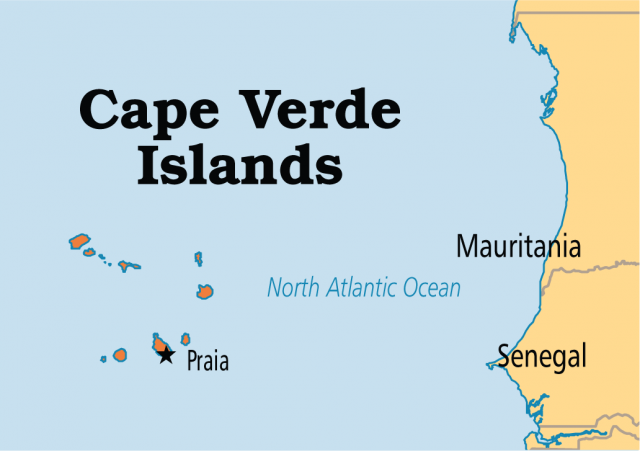Cape Verde
Area 1,557 square mi (4,033 square km)
Population 503,600 2014
Capital Praia
Highest Point Mt. Fogo 9,281 ft (2,829 m)
Lowest Point 0 m
GDP $1.871 billion 2014
Primary Natural Resources salt, basalt, limestone, kaolin, fish.
CAPE VERDE IS a volcanically produced archipelago, consisting of 10 major islands and five islets in the ATLANTIC OCEAN, 285 mi (460 km) off the coast of SENEGAL in Africa. Settled by the Portuguese sometime between 1455 to 1461, the uninhabited and resourcepoor Cape Verdes offered an early lesson in what today's marketing gurus refer to as: “location, location, location.” The craggy islands, with their hot, dry climate, were of little intrinsic value. Rain came sporadically, but sometimes in torrents, ruining whatever crops might otherwise grow.
Trade winds swept early sail-powered vessels to Cape Verde, and PORTUGAL capitalized, vigorously, on the islands' location. Descending from north to south, the AZORES, Madeiras, and Cape Verde formed strategically positioned stepping-stones to and from the Atlantic for Portugal. Their natural and manufactured resources were collectively leveraged for the Crown, and also offered an African trade axis with its own cultural and economic attributes.

Portugal carefully planned its colonial economies. Goats, which could survive virtually any terrain, were brought to Cape Verde even before settlers. A preservative and dietary supplement for long transoceanic voyages, salt proved to be the only redeemable natural resource. The Portuguese also envisioned Cape Verde as a trade outlet for their naval stores, but proximity to the African coast rendered slave-trading the largest commercial activity, peaking in the first half of the 17th century and ending in the early 19th, when most of the world outlawed it. In order to settle the islands and bolster their profitability, the Portuguese crown initially extended trade privileges to private firms and issued land grants with the hope of seeding plantationstyle agriculture. (Farming largely failed. Ironically, some of the best-growing crops, notably beans and squashes, were New World imports.)
Less privileged individuals arrived at Cape Verde, too: Former prisoners brought at government behest for their labor; Iberian Jews fleeing the Inquisition; independent adventurers of truly diverse nationalities; slaves and freed slaves (often liberated during times of extreme drought/famine when even wealthy Cape Verdeans could not provide for them); and their wellmixed progeny.
The early elite profited from government-granted status, but others were forbidden to trade with foreign countries and limited in what they could exchange (no guns to Africa, for example). They frequently flouted colonial dictates and embarked on their own trade, sometimes through smuggling. Generally, they learned to navigate—both commercially and culturally—the African coast with its myriad tribal leaderships. Three major trade classes subsequently emerged: tangomaus, originally black African traders who adapted to Portuguese culture; lancados, white Portuguese who ventured from Cape Verde to Africa; and grumetes, black or mixed-race servants who worked the boats and hauled cargo.
With the end of slave trading, Cape Verde returned to provisioning. Faster, more efficient steam ships plied the seas, and newly discovered coal and a good harbor at Mindelo (San Vicente Island) fueled the economy. Combined with poor conditions at home, increasing cosmopolitanism for the first time encouraged a major exodus: Seafarers from the island of Brava joined western-
bound whaling crews and, subsequently settled in RHODE ISLAND, CALIFORNIA, and primarily MASSACHUSETTS.
Cape Verde achieved recognition as a geocultural “broker” in the 20th century. In addition to building transportation facilities, Portugal established the islands as an educational center for its African colonies, with a seminary and secondary school. But the pervasive anticolonial movement sweeping the continent similarly inspired Cape Verdeans toward independence in 1975. All told, the islands' geographic position yielded a maritime economy descended from the Age of Exploration, and a unique Afro-Portuguese Crioulo (creole) culture that became better defined with the dissolution of colonialism.